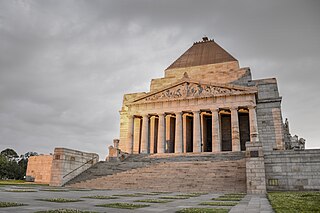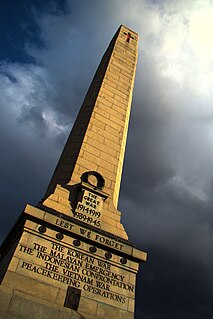
Hyde Park is a heritage-listed 16.2-hectare (40-acre) urban park located in the central business district of Sydney, in the City of Sydney local government area of New South Wales, Australia. It is the oldest public parkland in Australia. Hyde Park is on the eastern fringe of the Sydney city centre and is approximately rectangular in shape, being squared at the southern end and rounded at the northern end. It is bordered on the west by Elizabeth Street, on the east by College Street, on the north by St. James Road and Prince Albert Road and on the south by Liverpool Street.

Wagga Wagga is a major regional city in the Riverina region of New South Wales, Australia. Straddling the Murrumbidgee River, with an urban population of more than 56,000 as of June 2018, Wagga Wagga is the state's largest inland city, and is an important agricultural, military, and transport hub of Australia. The ninth largest inland city in Australia, Wagga Wagga is located midway between the two largest cities in Australia–Sydney and Melbourne–and is the major regional centre for the Riverina and South West Slopes regions.

The Anzac Memorial is a heritage-listed war memorial, museum and monument located in Hyde Park South near Liverpool Street in the CBD of Sydney, Australia. It is also known as Anzac War Memorial, War Memorial Hyde Park and Hyde Park Memorial. The Art Deco monument was designed by C. Bruce Dellit, with the exterior adorned with monumental figural reliefs and sculptures by Rayner Hoff, and built from 1932 to 1934 by Kell & Rigby. This state-owned property was added to the New South Wales State Heritage Register on 23 April 2010.

The Shrine of Remembrance is a war memorial in Melbourne, Victoria, Australia, located in Kings Domain on St Kilda Road. It was built to honour the men and women of Victoria who served in World War I, but now functions as a memorial to all Australians who have served in any war. It is a site of annual observances for ANZAC Day and Remembrance Day, and is one of the largest war memorials in Australia.

ANZAC Square is a heritage-listed town square and war memorial located between Ann Street and Adelaide Street, in Brisbane, Queensland, Australia. It is a state memorial to the men and women who participated in overseas armed service and is named in honour of the Australian and New Zealand Army Corps. ANZAC Square is adjacent to ANZAC Square Arcade.
William Leonard Gammage is an Australian academic historian, Adjunct Professor and Senior Research Fellow at the Humanities Research Centre of the Australian National University (ANU). Gammage was born in Orange, New South Wales, went to Wagga Wagga High School and then to ANU. He was on the faculty of the University of Papua New Guinea and the University of Adelaide. He is a fellow of the Australian Academy of Social Sciences and deputy chair of the National Museum of Australia.
The history of Wagga Wagga details the growth of the city from a small crossing on the Murrumbidgee River to the largest city and regional centre of the Riverina region of New South Wales, Australia.

The Sydney Cenotaph is a heritage-listed monument located in Martin Place, in the Sydney, Australia. It was designed by Bertram Mackennal and built from 1927 to 1929 by Dorman Long & Co. It is also known as Martin Place Memorial and The Cenotaph. It is one of the oldest World War I monuments in central Sydney. It was added to the New South Wales State Heritage Register on 11 November 2009.

Hobart Cenotaph is the main commemorative military monument for the Australian state of Tasmania. It is located in the capital Hobart in a prominent position on the Queens Domain, on a small rise overlooking the city and River Derwent. The Cenotaph sits directly above what was once the location of the Queens Battery.

The National War Memorial is a monument on the north edge of the city centre of Adelaide, South Australia, commemorating those who served in the First World War. Opened in 1931, the memorial is located on the corner of North Terrace and Kintore Avenue, adjacent to the grounds of Government House. Memorial services are held at the site throughout the year, with major services on both Anzac Day (25 April) and Remembrance Day (11 November).

Anzac Avenue is a heritage-listed major arterial road lined with trees in the Moreton Bay Region, Queensland, Australia. It runs 17.8 kilometres (11.1 mi) from Petrie to Redcliffe, with most of the route signed as state route 71. The route was formerly the main route to the Redcliffe peninsula, until the Hornibrook Bridge was built.

The Fremantle War Memorial is a war memorial located on Monument Hill, an 11-acre (4.45-hectare) public reserve and hill in Fremantle, Western Australia. The memorial itself comprises a large obelisk, the Fallen Soldiers' and Sailors' Memorial, surrounded by eight smaller memorials. The site, located on High Street near the centre of Fremantle, overlooks Fremantle Harbour, and was established by the Fremantle Town Council in 1928 to commemorate the losses of the First World War, having been used as a public reserve since the early 19th century.

Soldiers Memorial Hall is a heritage-listed memorial at 149 Herries Street, Toowoomba City, Queensland, Australia. It was designed by Hodgen & Hodgen (Toowoomba) and built from 1923 to 1959 by Smith Bros (Toowoomba). It was added to the Queensland Heritage Register on 17 December 1999.

Gair Park is a heritage-listed park and memorial at 181 Annerley Road, Dutton Park, City of Brisbane, Queensland, Australia. It was built from 1936 onwards. It was added to the Queensland Heritage Register on 5 April 2004.

South African War Memorial is a heritage-listed memorial at ANZAC Square, 228 Adelaide Street, Brisbane City, City of Brisbane, Queensland, Australia. It was sculpted by James Laurence Watts from 1912 to 1919. It is also known as Boer War Memorial and The Scout. It was added to the Queensland Heritage Register on 21 October 1992.

Stanthorpe Soldiers Memorial is a heritage-listed war memorial at Lock Street, Stanthorpe, Southern Downs Region, Queensland, Australia. It was designed by Dornbusch & Connolly and built from 1925 to 1926 by N J Thompson & Sons. It is also known as Stanthorpe War Memorial. It was unveiled on 6 February 1926, by Sir William Glasgow, K.C.G. It was added to the Queensland Heritage Register on 3 August 1995.

Anzac Day is a day of remembrance in Queensland, Australia. It is a public holiday held on 25 April each year. The date is significant as the Australian and New Zealand troops first landed at Gallipoli in World War I on 25 April 1915.

Cairns War Memorial is a heritage-listed memorial at The Esplanade, Cairns, Cairns Region, Queensland, Australia. It was built in 1925. It was added to the Queensland Heritage Register on 21 October 1992.

The Southport RSL is a sub-branch of Returned and Services League of Australia (RSL) in Southport, Gold Coast in South East Queensland, Australia. Their building is at 36 Scarborough Street, Southport. The Southport RSL is a registered not-for-profit charity.

Pialba Memorial Cenotaph is a heritage-listed memorial at Freedom Park, Main Street, Pialba, Fraser Coast Region, Queensland, Australia. It was designed by Philip Oliver Ellard Hawkes and built from 1918 to 1921 by Frederick William Webb. It was added to the Queensland Heritage Register on 6 May 2016. It is also known as the Pialba War Memorial and the Hervey Bay War Memorial.



















